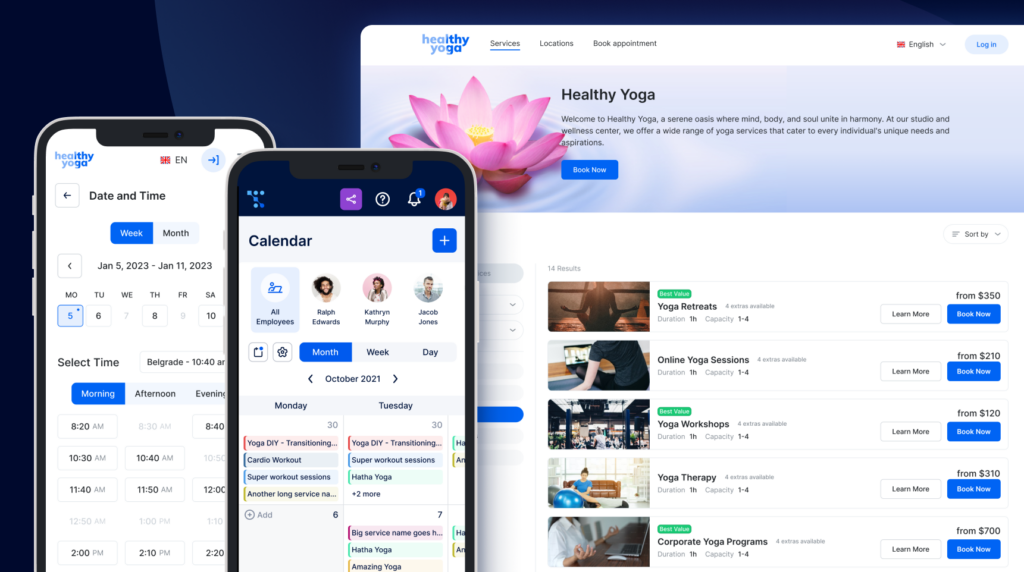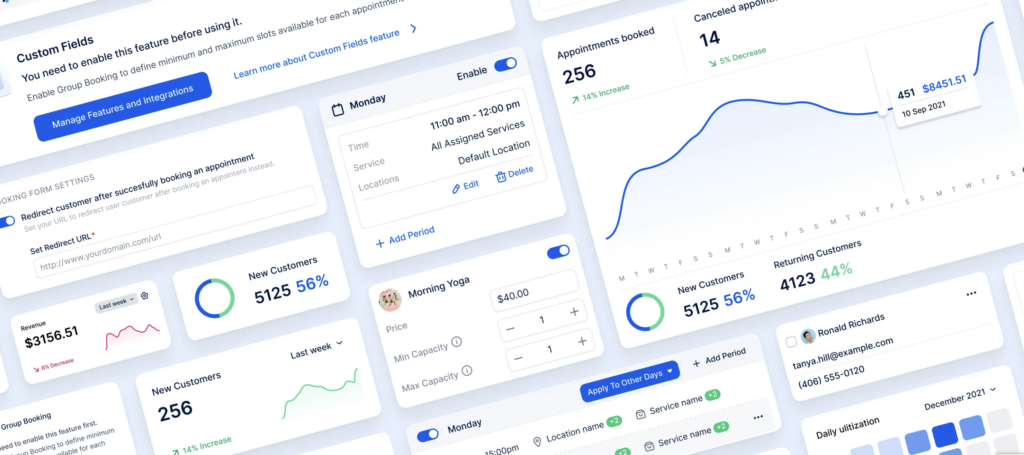Managing appointments and bookings efficiently is crucial for businesses across various industries. Whether you run a spa, a medical clinic, or a fitness center, having the right scheduling software can make a world of difference. Two popular options in the appointment booking software market are Amelia and Trafft.
In this article, we will compare and contrast these two platforms to help you decide which one is the best fit for your business.
Let’s dive in!
Note: you can always jump straight to our FAQ section, where you’ll find the answers to the most commonly asked questions.
What Is Amelia?
Amelia is a versatile booking plugin designed exclusively for WordPress websites. For this reason, Amelia is an excellent choice for businesses that rely on WordPress for their online presence.
Amelia is a particularly good fit for business owners and managers who have certain technical knowledge and are prepared to take on additional responsibilities. One of the aspects of having a WordPress plugin is the fact that it places a significant share of the configuration and maintenance burden on the client’s (or admin’s) shoulders. This includes tasks such as setting up a server, managing AWS infrastructure, load balancing, hiring a developer to create a website, configuring daily backups, monitoring, and alerts, and ensuring the protection of the database.
Amelia operates within the confines of the client’s server, distinguishing it from cloud-based solutions, which handle many of these tasks on the user’s behalf. In addition, it’s important to note that Amelia operates within the WordPress ecosystem, which primarily relies on PHP as its core technology. As a result, there are certain limitations when it comes to capabilities such as creating mobile apps. Also, some integrations may have restrictions due to the WordPress framework.
Users should consider these factors when evaluating Amelia as a booking plugin for their WordPress website.
What Is Trafft?
Trafft is highly versatile and comprehensive scheduling software designed to streamline and automate appointment and booking processes for businesses across various industries. It functions as a standalone booking solution, making it an excellent choice for businesses that require flexibility, multi-location management, and advanced features.
Trafft is built with industry-leading standards both in terms of interfaces and business goal orientation. It employs top-of-the-line technologies and infrastructure, including AWS for load balancing, file storage, and database management, as well as high-availability server infrastructure from major European data centers. Rigorous penetration and security tests ensure the utmost safety and protection of your business data.
Why is Trafft unique?
Beyond its core functions, Trafft aspires to be more than just software. It adopts a Digital Business Partner concept and aims to accumulate industry knowledge, offering guidance, shared insights, whitepapers, and webinars to help business owners stay informed and optimize their operations.
Essentially, Trafft is a comprehensive business management and automation service, designed to help you organize, manage, and grow your business. Trafft sets a new standard, providing enterprise-grade reliability and performance that goes far beyond what’s achievable with a WordPress solution.
Amelia vs. Trafft: What Are the Key Differences Between These Two Booking Solutions?

While Amelia simplified the automation of booking, scheduling, and business workflow configuration for service-based businesses with WordPress websites, Trafft represents the next step.
With Trafft, you can:
Go from forms to full websites in a matter of minutes
Unlike traditional booking plugins used for WordPress-powered websites, Trafft is designed to be more than just a set of forms hosted on your website. With Trafft, you have the flexibility to build complete websites, booking pages, or forms that can be seamlessly integrated into your website.
Kick back and let the Trafft team worry about everything
Essentially, Trafft aims to remove all the intermediary steps and tools, positioning itself as the single platform for taking your service business online. You won’t need to worry about creating a website, purchasing hosting, configuring backups, and maintaining the latest versions of WordPress, themes, and plugins. Trafft takes care of all these aspects, eliminating the need for dealing with support and ensuring a secure and mobile-optimized website.
And the best thing? You won’t need to delve into the technical aspects because everything is hosted and managed by the Trafft team, as part of the comprehensive package. This includes servers, infrastructure, backups, and monitoring, all of which are delivered to you, making it a hassle-free solution for businesses of various scales.
Run your business from the palm of your hand
Also, Trafft has recently launched a mobile app, something that is not feasible with Amelia due to WordPress limitations. Additionally, there will be a desktop application available for installation on business laptops.
Decide who gets full access to your booking website
Moreover, what a typical WordPress user deals with on a daily basis can be a bit overwhelming. What does this mean in practice? Basically, if your not-so-tech-savy employees need to access their appointments or settings, they’ll have to log in to the Admin Dashboard. From there – they have full access to all the aspects of your website. And that’s something you’ll want to avoid, especially if you have multiple employees.
Streamline your business operations
Finally, WordPress, originally developed as a blogging engine, carries with it certain architectural and flow limitations that might not be ideal for business-oriented customers. When using WordPress, you have to find workarounds and use patches and tricks in order to set up your ideal business environment, whereas that’s not necessary with narrow task-specialized software like Trafft.
Amelia vs. Trafft: Key Features Overview
Although they share a significant number of features, both booking systems come equipped with their own distinct set of features.
Let’s take a closer look at some of the most prominent features Amelia and Trafft have:
| Key Features | Amelia | Trafft |
| No-code booking website |
|
|
| Embeddable & shareable booking form |
|
|
| Custom domain |
|
|
| Multilingual support |
|
|
| Customization options |
|
|
| Custom fields |
|
|
| Auto-detect time zones |
|
|
| User roles & permissions |
|
|
| Employee schedule management |
|
|
| Automated SMS & email notifications and reminders |
|
|
| Taxes & invoices |
|
|
| Multiple services |
|
|
| Multiple locations |
|
|
| Group booking |
|
|
| Recurring appointments |
|
|
| Packages of services |
|
|
| Event booking |
|
|
| Resources |
|
|
| REST APIs management |
|
|
| Business dashboard & reporting |
|
|
| Payment processing |
|
|
| Deposit & refund payment |
|
|
| Calendars and video conferencing integrations |
|
|
| Marketing tools integrations |
|
|
Amelia vs. Trafft: Similarities
As you can see, Trafft’s features and Amelia’s features are quite similar in nature.
Firstly, both platforms provide the essential ability: they automate the entire appointment scheduling and calendar management process, ensuring a seamless booking experience for business owners and customers. They allow for customization, enabling businesses to tailor the booking process to match their brand’s look and feel. Additionally, both platforms support custom fields, a valuable feature for collecting specific information during the booking process.
Both Amelia and Trafft excel in user roles and permissions management. This allows businesses to define access levels and responsibilities for staff members. They facilitate employee schedule management, helping businesses efficiently allocate staff resources. Furthermore, the platforms automate SMS and email notifications and reminders, reducing no-shows and improving communication with clients.
Both Amelia and Trafft also offer extensive support for tax calculations and invoice generation. Although Amelia doesn’t have a separate feature dedicated to taxes and invoices, you can still manage them via Amelia’s WooCommerce integration. Moreover, they seamlessly integrate with various payment gateways and allow for deposit and refund payments, catering to businesses’ financial needs.
What’s more, both appointment scheduling systems provide the flexibility to manage multiple services, locations, group bookings, and recurring appointments. This makes them versatile solutions for various industries. Moreover, they offer a seamless integration with calendars, video conferencing tools, and marketing software, enhancing their overall functionality.
The bottom line is that Amelia and Trafft share several key features that are crucial for businesses looking to enhance their booking and appointment management processes. Their capabilities in customization, user management, and automation make them valuable tools for businesses of all sizes and types.
However, although similar, Amelia and Trafft have their own sets of distinctive features that give each solution its unique flavor.
Amelia vs. Trafft: Differences
Note: For the purposes of this comparison, we will refer to distinguishing features offered by both solutions.
Amelia’s distinctive features
- Packages of services: Amelia empowers businesses to offer and manage bundled services with ease. This not only simplifies the booking process for clients but also opens up new opportunities for businesses to increase revenue, enhance customer loyalty, and effectively market their services.
- Event booking and management: Amelia simplifies event management from start to finish. It offers businesses and event organizers a comprehensive solution for creating, customizing, and managing events, whether they are in-person or online. From registration and capacity management to ticket purchasing, payment processing and reporting, this feature ensures that your events run smoothly and successfully, providing a seamless experience for both organizers and participants.
- Resources: This feature enables businesses to optimize their resource allocation and management. Whether you’re scheduling rooms, equipment, cars, chairs, or any other assets, this feature simplifies the process and ensures that resources are allocated efficiently, reducing conflicts, and improving customer service.
- REST APIs management: Amelia’s REST APIs Management feature provides businesses with the flexibility and power to integrate and extend the capabilities of the Amelia booking system with external applications, software, websites, or services, providing opportunities for customization and automation.
Trafft’s distinctive features
- No-code booking website: Trafft’s no-code approach means that you don’t need to be a web developer or have any coding skills to create a professional and functional booking website. The platform provides an intuitive and user-friendly interface that guides you through the process.
- Embeddable & shareable booking form: Trafft’s embeddable booking form can be effortlessly integrated into your website. Also, you can generate shareable booking links, which means you can easily share the booking form with customers through various channels, including emails, social media, and messaging apps.
- Custom domain: Trafft allows you to use a custom domain for your booking website. This means you can have a web address that reflects your brand, enhancing credibility and making it easier for customers to find and remember your site.
- Multilingual support: Trafft’s booking website supports multiple languages, a crucial feature for businesses serving a diverse customer base. This ensures that you can reach and serve customers from around the world in their preferred language.
Are Amelia and Trafft Competing?
Not at all; in fact, it’s quite the opposite.
While Amelia and Trafft serve similar purposes, they cater to different needs and preferences. Amelia is a WordPress-specific plugin that’s well-suited for businesses with WordPress websites. Trafft, on the other hand, is a versatile, standalone scheduling software suitable for various industries and business types.
You can think of Trafft as an evolution of Amelia into a SaaS (Software as a Service) platform, a path it was initially intended to follow.
Both Amelia and Trafft share the same parent company, but they operate with distinct teams, technical leads, developers, project managers, and quality assurance professionals. They have separate roadmaps and cater to slightly different target audiences.
Being part of the same company allows proactive knowledge exchange, which ultimately results in product improvements. The fact that Amelia has been around for a long time left room for Trafft to learn from Amelia’s experiences and avoid some of the mistakes. This collaboration between the two has benefited both platforms, leading to faster feature development and better user experiences.
Today, the development teams work in parallel, and after launching new features, they collaborate to exchange ideas and gather feedback from the market. This process enables the integration of successful features into both products, enriching the overall offerings of Amelia and Trafft and enhancing their respective capabilities.
Amelia vs. Trafft: Which One to Choose

When deciding between Amelia and Trafft, it’s essential to consider your specific business needs, team size, and preferences.
Amelia is an ideal choice if you:
- Have a smaller team, typically with up to 10 members;
- Run a business that handles a relatively modest number of appointments.
- Have a good grasp of technical language and operate a WordPress website.
- Want to maintain ownership of your database and keep everything hosted on your own server.
On the other hand, Trafft should be your go-to booking solution in the following scenarios:
- Trafft is an excellent fit for very small use cases, as it offers a free plan for teams of up to 5 people.
- At the same time, it’s a perfect choice for more serious businesses handling a higher volume of appointments, sometimes even hundreds per month.
- Great for businesses that don’t need a website at all, as they rely solely on platforms like Instagram for marketing.
- Ideal for businesses that wish to separate website management from booking management.
- A perfect booking solution for businesses seeking to offload technical issues like organizing the database, data backup, performance, speed optimization, and other server-related tasks.
So, whether your business falls into the category of a very small-scale operation or a more substantial enterprise, Trafft provides the flexibility and capabilities to match your specific requirements.
When to upgrade to Trafft from Amelia
The decision to upgrade from Amelia to Trafft can be a strategic one, particularly when your business experiences specific milestones and operational changes.
One such moment is when your business starts handling a substantial number of appointments, typically reaching a few hundred per month.
As your business grows, you may also find that multiple individuals are working within the system, each with their specific roles and responsibilities. At this point, you might prefer not to grant access to your website’s admin dashboard to various team members.
Trafft becomes an ideal solution to streamline and centralize your booking and appointment management processes while enhancing security and efficiency. This transition allows businesses to maintain robust control over their operations while accommodating the growing complexities of a larger team and appointment volume.
If you’re currently using Amelia and find that your business has outgrown its capabilities, it might be time to consider upgrading to Trafft.
Get in touch with us for a smooth upgrade and unlock exclusive discounts on Trafft!
Amelia vs. Trafft FAQ
1. Are Amelia and Trafft developed by the same company?
Yes, both Amelia and Trafft are developed by the same company (TMS). They share the same corporate umbrella, which allows for knowledge exchange and collaboration between the two teams. While they share a common parent company, they have separate teams and roadmaps, which enables them to cater to different target audiences and evolve independently.
2. Do Amelia and Trafft belong to the same product family?
Yes, Amelia and Trafft belong to the same product family, similar to how iMac and MacBook are both developed by Apple. While they share a common corporate parent, they cater to different use cases and audiences, offering versatile solutions for businesses with varied requirements.
3. Isn’t it a conflict of interest to have two competing products under the same roof?
It might seem counterintuitive to have two competing products under the same company, but in the case of Amelia and Trafft, it’s a strategic decision. The shared corporate umbrella fosters proactive knowledge exchange, which has proven to be an effective way to speed up feature development for both products. While they may share similarities, they also have distinct features and target audiences. This arrangement allows the company to offer a broader range of solutions to businesses with varying needs.
4. How does this parallel development of two products reflect on customers?
The synergy between Amelia and Trafft ultimately benefits customers. It means that lessons learned from the development of one product can be applied to enhance the other. For example, Trafft has benefited from Amelia’s experiences, avoiding certain mistakes and limitations encountered in Amelia’s journey. This results in a more streamlined and feature-rich experience for Trafft users.
It’s a win-win situation, as the exchange of ideas and features between the two products leads to improved offerings for customers. The choice between Amelia and Trafft depends on the unique requirements and preferences of each business, allowing customers to find the best solution for their specific needs.
5. Will prioritizing the development of one product negatively impact the development pace of the other product?
Not at all. The focus on one product’s development doesn’t mean that the other will slow down. In fact, it’s quite the contrary. The exchange of ideas and experiences often leads to accelerated feature development for both, benefiting users of both products.
Also, the development teams work separately on each product, ensuring that neither’s progress hampers the other’s.
6. Do Amelia and Trafft share the same development team?
While both products share the same corporate umbrella, they have separate development teams, each with its own technical leads and project managers. These distinct teams allow for focused and independent product development.
7. What is the greatest difference between Amelia and Trafft?
The most significant difference between Amelia and Trafft lies in their core design and functionality. While both are booking and appointment management systems, Amelia is a WordPress plugin, primarily suited for businesses looking to integrate booking capabilities into their WordPress-powered websites.
In contrast, Trafft is a comprehensive business management and automation service designed to be more than just forms on a website. It offers features like a no-code booking website, multilingual support, and a broader range of integrations. So, the choice between the two depends on the specific needs of your business.
8. Do Amelia and Trafft cater to the same target audience?
Amelia and Trafft have some overlapping features but are designed for different target audiences. Amelia is a WordPress plugin primarily intended for businesses looking to integrate booking features into their existing WordPress websites.
Trafft, on the other hand, serves a broader audience, from small businesses to more extensive operations. Using Trafft doesn’t require you to have a website. However, at the same time, you can make one using Trafft within minutes. It’s a perfect choice if you want to manage bookings across various channels, including websites, messengers, and social media.
9. What are the ideal use cases for Amelia?
Amelia is an excellent choice for businesses that already have a WordPress website. Moreover, Amelia is a powerful tool for users with the technical know-how to manage a WordPress site and who want to take ownership of their website’s database and server maintenance.
10. What are the ideal use cases for Trafft?
Trafft is designed to handle a range of use cases. It’s an ideal solution for businesses with a wide array of requirements. Whether you’re a very small operation with up to five people or a more extensive business with hundreds of monthly appointments, Trafft can accommodate your needs. It’s especially beneficial for those who either don’t need a website or prefer to separate website management from booking management.
Trafft also takes care of the technical aspects of your booking website. This includes hosting, infrastructure, backups, and monitoring, making it a versatile choice for various business scenarios.



